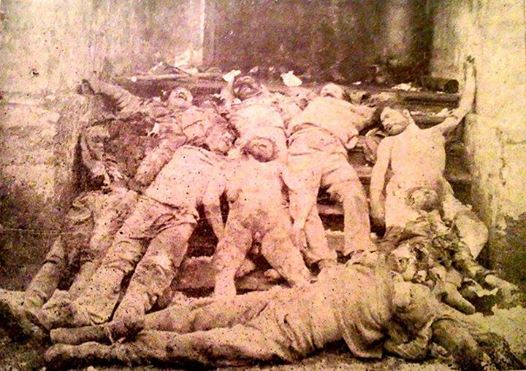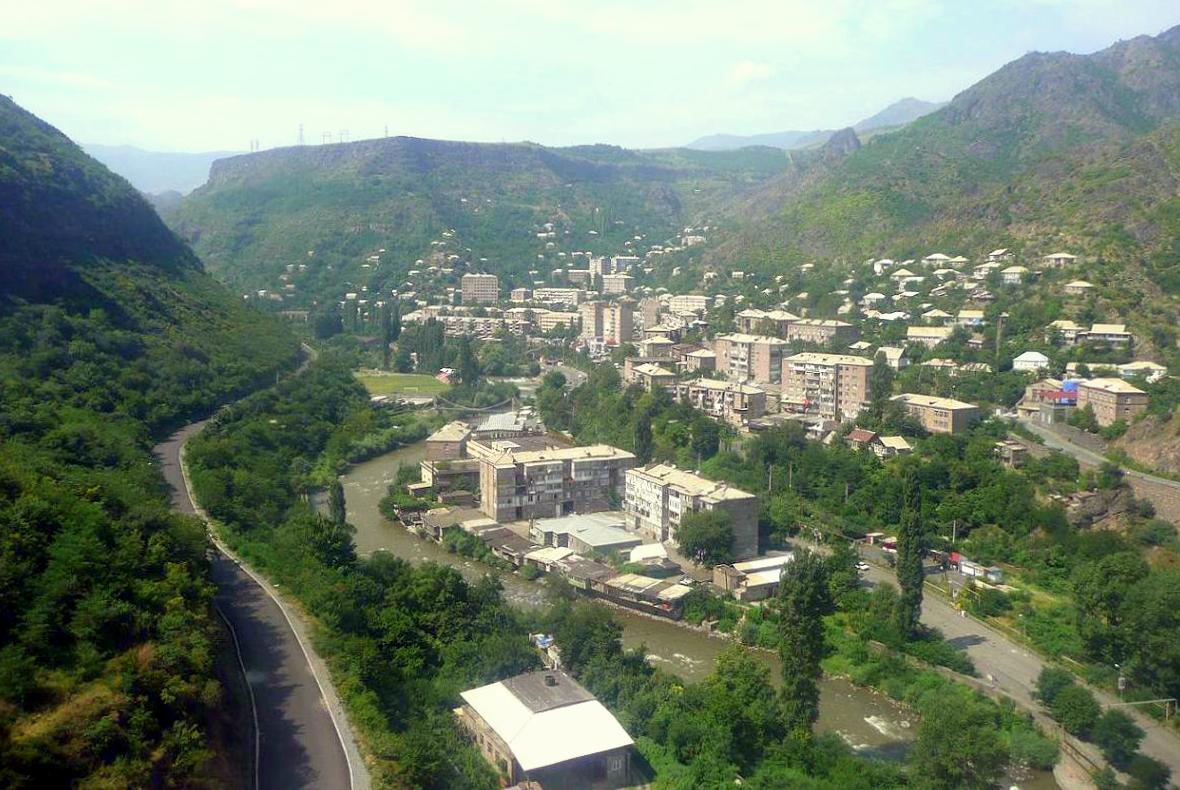|
Poghos Bek-Pirumyan
Poghos Bek-Pirumyan (; 8 June 1856 – 19 January 1921) was an Armenian military commander. He served as a colonel for the Russian Empire in World War I and was a commander of the Battle of Sardarabad. Biography Poghos Bek-Pirumyan was born on 8 June 1856 in Nakhichevanik village of the Shusha uezd of the Elizavetpol Governorate within the Russian Empire. He is the cousin of Daniel Bek-Pirumian. Poghos graduated from the high school in Shusha, then attended cadet school, and joined the Imperial Russian Army in 1878. He held several positions of battalion and regiment commander, and participated in both the Russo-Turkish War of 1877–78 and the Russo-Japanese War of 1904–05. In 1914, Bek-Pirumyan retired, but came out of retirement that same year with the outbreak of World War I. Bek-Pirumyan fought on the Western Front, and then in the Caucasus Campaign. Since 1916, he was the commander of the 5th Armenian Rifle Regiment, which participated in the battles of Van and Mush. ... [...More Info...] [...Related Items...] OR: [Wikipedia] [Google] [Baidu] |
Nakhichevanik
Nakhichevanik ( hy, Նախիջևանիկ, Nakhijevanik) or Nakhchivanly ( az, Naxçıvanlı) is a village ''de facto'' in the Askeran Province of the breakaway Republic of Artsakh, ''de jure'' in the Khojaly District of Azerbaijan, in the disputed region of Nagorno-Karabakh. The village has an ethnic Armenian-majority population, and also had an Armenian majority in 1989. History The modern village was founded in the 15th century. During the Soviet period, the village was part of the Askeran District of the Nagorno-Karabakh Autonomous Oblast. Historical heritage sites Historical heritage sites in and around the village include tombs from the 2nd–1st millennia BCE, the village of ''Varder'' ( hy, Վարդեր) from between the 16th and 19th centuries, the 17th-century church of ''Surb Astvatsatsin'' ( hy, Սուրբ Աստվածածին, ), and an 18th/19th-century cemetery. Economy and culture The population is mainly engaged in agriculture and animal husbandry. As ... [...More Info...] [...Related Items...] OR: [Wikipedia] [Google] [Baidu] |
February Uprising
The February Uprising ( classical hy, Փետրուարեան ապստամբութիւն, reformed: Փետրվարյան ապստամբություն, ''P'etrvaryan apstambut'yun'') was an anti-Bolshevik rebellion by the nationalist Armenian Revolutionary Federation which started on February 13 and was suppressed on April 2, 1921 by the recapture of Yerevan by Bolshevik forces. Background After the Republic of Armenia was Sovietized in December 1920 about 1,000 Armenian officers were arrested by the new Bolshevik authorities, including generals Tovmas Nazarbekian and Movses Silikyan. They were forced to walk from Yerevan to Alaverdi by foot (about 160 kilometers) and some of them were killed on the road. These officers were subsequently sent to jails in Baku and Russia. In February 1921, many heroes of the Battle of Sardarabad were shot, including Daniel Bek-Pirumyan, while his brother Poghos Bek-Pirumyan committed suicide after being tortured. Pro-Armenian Revolutionary Fed ... [...More Info...] [...Related Items...] OR: [Wikipedia] [Google] [Baidu] |
Alaverdi, Armenia
Alaverdi ( hy, Ալավերդի, ), is a town and municipal community in the Lori Province at the northeastern part of Armenia, near the border with Georgia. It is located at the only direct rail link between Armenia and Georgia. Situated at the bottom of the Debed river gorge, Alaverdi is an important commercial and industrial centre in northern Armenia. As of the 2011 census, the population of the town is 13,343, down from 26,300 reported in 1989. Currently, the town has an approximate population of 11,000 as per the 2016 official estimate. Etymology Historically, the area around Alaverdi was known as Manasgomer or Manits Gom during the medieval period. Starting from the 17th century, the settlement became known as Alaverdi, derived from the name of a 17th-century Turkic ''Borçalı'' tribe leader ''Allahverdi Mollaoğlu Tarkhan''. However, Alaverdi was formed as a settlement known as Manes (from historical Manits Gom) only in 1899, when the copper smelter was opened near ... [...More Info...] [...Related Items...] OR: [Wikipedia] [Google] [Baidu] |
Yerevan
Yerevan ( , , hy, Երևան , sometimes spelled Erevan) is the capital and largest city of Armenia and one of the world's List of oldest continuously inhabited cities, oldest continuously inhabited cities. Situated along the Hrazdan River, Yerevan is the administrative, cultural, and industrial center of the country, as its primate city. It has been the Historical capitals of Armenia, capital since 1918, the Historical capitals of Armenia, fourteenth in the history of Armenia and the seventh located in or around the Ararat Plain. The city also serves as the seat of the Araratian Pontifical Diocese, which is the largest diocese of the Armenian Apostolic Church and one of the oldest dioceses in the world. The history of Yerevan dates back to the 8th century BCE, with the founding of the fortress of Erebuni Fortress, Erebuni in 782 BCE by King Argishti I of Urartu, Argishti I of Urartu at the western extreme of the Ararat Plain. Erebuni was "designed as a great administrative an ... [...More Info...] [...Related Items...] OR: [Wikipedia] [Google] [Baidu] |
Araks River
, az, Araz, fa, ارس, tr, Aras The Aras (also known as the Araks, Arax, Araxes, or Araz) is a river in the Caucasus. It rises in eastern Turkey and flows along the borders between Turkey and Armenia, between Turkey and the Nakhchivan exclave of Azerbaijan, between Iran and both Azerbaijan and Armenia, and, finally, through Azerbaijan where it flows into the Kura river. It drains the south side of the Lesser Caucasus Mountains while the Kura drains the north side of the Lesser Caucasus. The river's total length is and its watershed covers an area of . The Aras is one of the longest rivers in the Caucasus. Names In classical antiquity, the river was known to the Greeks as Araxes ( gr, Ἀράξης). Its modern Armenian name is ''Arax'' or ''Araks'' ( hy, Արաքս). Historically it was also known as ''Yeraskh'' ( xcl, Երասխ) and its Old Georgian name is ''Rakhsi'' (). In Azerbaijani, the river's name is ''Araz''. In Persian and Kurdish its name is (''Aras''), an ... [...More Info...] [...Related Items...] OR: [Wikipedia] [Google] [Baidu] |
Rout
A rout is a panicked, disorderly and undisciplined retreat of troops from a battlefield, following a collapse in a given unit's command authority, unit cohesion and combat morale (''esprit de corps''). History Historically, lightly-equipped soldiers such as light cavalry, auxiliaries, partisans or militia were important when pursuing a fast-moving, defeated enemy force and could often keep up the pursuit into the following day, causing the routed army heavy casualties or total dissolution. The slower moving heavy forces could then either seize objectives or pursue at leisure. However, with the advent of armoured warfare and '' blitzkrieg'' style operations, an enemy army could be kept more or less in a routed or disorganized state for days or weeks on end. In modern times, a routed formation will often cause a complete breakdown in the entire front, enabling the organized foe to attain a quick and decisive victory in the campaign. In the blitzkrieg warfare that charact ... [...More Info...] [...Related Items...] OR: [Wikipedia] [Google] [Baidu] |
Yakub Shevki Pasha
Yakub or Yaqub ( ar, يعقوب, Yaʿqūb or Ya'kūb , links=no, also transliterated in other ways) is a male given name. It is the Arabic version of Jacob and James. The Arabic form ''Ya'qūb/Ya'kūb'' may be direct from the Hebrew or indirectly through Syriac. Jane Dammen McAuliffe (General Editor) Encyclopaedia of the Qur’an Volume Three : J-O The name was in use in pre-Islamic Arabia and is a common given name in Arab, Turkish, and Muslim societies. It is also used as a surname. It is common in Polish, Czech and Slovak languages, where it is transliterated as Jakub. Yakub may also refer to: Religious figures * Yāˈqub bin Isḥāq bin Ibrāhīm (Jacob), prophet of Islam *Yakub (Nation of Islam), creator of the white race according to that belief system * Syed Yaqub, a 14th-century Sufi Muslim figure in the Sylhet region *Yaqub al-Charkhi (1360–1360), Naqshbandi Sheykh and student of Khwaja Baha' al-Din Naqshband Other people with this given name Pre-modern times *Y ... [...More Info...] [...Related Items...] OR: [Wikipedia] [Google] [Baidu] |
Armenian Soviet Encyclopedia
The ''Armenian Soviet Encyclopedia'' ( hy, Հայկական սովետական հանրագիտարան, ''Haykakan sovetakan hanragitaran''; ASE) publishing house was established in 1967 as a department of the Institute of History of the Armenian Academy of Sciences under the presidency of Viktor Hambardzumyan (1908–1996), co-edited by Abel Simonyan (1922–1994) and Makich Arzumanyan (1919–1988). In 1988–1999 the editor-in-chief was Konstantin Khudaverdyan (1929–1999) and since 1999 Hovhannes Aivazyan. It produced the ''Soviet Armenian Encyclopedia'' (also rendered ''Armenian Soviet Encyclopedia''; '' hy, Հայկական Սովետական Հանրագիտարան'', ', ''russian: Армя́нская сове́тская энциклопе́дия'', ' ) from 1974–1986. The AE publishing house also edited a children's encyclopedia, ''Who is it? What is it?'' ( hy, italic=yes, Ո՞վ է, Ի՞նչ է) in 4 volumes (1984–87), the ''Russian-Armenian Polytechnical Dic ... [...More Info...] [...Related Items...] OR: [Wikipedia] [Google] [Baidu] |
Movses Silikyan
Movses Silikyan or Silikov (, ; 14 September 1862 – 22 November 1937) was an Armenian general who served in the Imperial Russian Army during World War I and later in the army of the First Republic of Armenia. He is regarded as a national hero in Armenia for his role in the Armenian victory at the Battle of Sardarabad. Following Russia's withdrawal from Transcaucasia and conclusion of a separate peace with the Ottoman Empire under the Treaty of Brest-Litovsk in March 1918, Silikyan and other Armenian generals organized the defense of Armenia against invading Ottoman forces. After the Armenian victories at the battles of Sardarabad, Karakilisa and Bash Abaran in May 1918, the First Republic of Armenia declared its independence. Silikyan received the rank of lieutenant general of the Armenian army and held various top military positions. Following the Sovietization of Armenia in 1920, Silikyan was exiled to Ryazan along with other high-ranking Armenian military officers, but was ... [...More Info...] [...Related Items...] OR: [Wikipedia] [Google] [Baidu] |
Muş
Muş (; hy, Մուշ; ku, Mûş) is a city and the provincial capital of Muş Province in Turkey. Its population is mostly Kurds. Etymology Various explanations of the origin of Muş's name exist. Its name is sometimes associated with the Armenian word ''mshush'' ( hy, մշուշ), meaning fog, explained by the fact that the town and the surrounding plain are frequently covered in fog in the mornings. The 17th-century explorer Evliya Çelebi relates a myth where a giant mouse created by Nemrud (Nimrod) destroys the city and its inhabitants, after which the city was named Muş (''muš'' means "mouse" in Persian).. Others have proposed a connection with the names of different ancient Anatolian peoples, the Mushki or the Mysians, or the toponyms ''Mushki'' and ''Mushuni'' mentioned in Assyrian and Hittite sources, respectively. History Ancient and medieval The date of foundation of Mush is unknown, although a settlement is believed to have been around by the time of Menua, ... [...More Info...] [...Related Items...] OR: [Wikipedia] [Google] [Baidu] |



.jpg)



